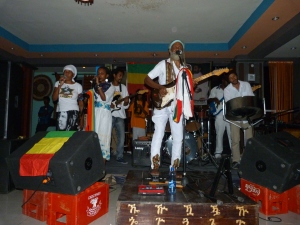by David Aarons

On the 21st April 2016, at about the same time that Prince Ermias Sahle-Selassie arrived in Jamaica to mark the 50th anniversary of Emperor Haile Selassie’s visit to the island, I sat in the Villa Verde restaurant in Addis Ababa at a concert that was also held in celebration of the Emperor’s Jamaican excursion. After a bit of a late start, the MC announced, “we are here tonight to celebrate a special event that happened fifty years ago. Haile Selassie from I-thiopia went to visit Jamaica to make sure that the link can be done between the Caribbean and Africa.”
Fifty years later and this link, this connection still very much exists—music being key to its maintenance in Ethiopia. At this concert, the Black Lion Reggae Band, which comprised mainly Ethiopian instrumentalists and singers and led by a Jamaican Rastafarian, performed numerous reggae selections as part of the evening’s programme. The grooving roots reggae band pumped out hits from Bob Marley to Chronixx, with a song from the late Ethiopian reggae artiste Eyob Mekkonen. Although the event was poorly attended (it was held during the major fasting season) and there were no songs that explicitly mentioned Haile Selassie, this reggae concert (like many reggae concerts in Ethiopia) symbolized the lasting legacy of the famous visit, albeit in subtle ways.
Many Rastafarians regard reggae as the King’s music, or a genre that glorifies the King of Kings, Emperor Haile Selassie. For many Ethiopian artistes, however, singing about Haile Selassie can be interpreted as a political act and is often avoided. That the Ethiopian performers at this concert never sang about Haile Selassie is therefore understandable given the context. But this was an event that was to celebrate the special moment of contact between HIM and Jamaicans. How was this achieved without substantial references to the King’s vision, teachings, and international policies? While the music may have not made it obvious to concert goers that this was a celebration of the famous visit, the legacy of his visit to Jamaica was present beneath the surface. To see this, one has to go back 50 years.
For starters, although he visited other Caribbean countries, Haile Selassie’s visit to Jamaica was the major event that sparked Rastafarians’ exodus to Ethiopia. Haile Selassie offered land in Ethiopia to Africans in the West from the middle of the twentieth century but it was not until his visit to Jamaica that most Rastafarians took up the call and moved to Ethiopia, the Promised Land. As the Rastafarian presence began to grow in Ethiopia over the following decades, cultural exchanges between Ethiopians and Rastafarians took place in myriad forms, but arguably none quite as creative and innovative as heard in the reggae music in Ethiopia.
Due to the growing Rastafarian presence in Ethiopia, many Ethiopians have benefited from the musical expertise of reggae musicians who came from Jamaica, Trinidad and Tobago, England, and the USA. As Rastafarian and Ethiopian musicians interact in rehearsal settings and jam sessions, they exchange musical ideas, spiritual philosophies, and cultural behaviours. At the celebration concert which I attended, many of the Ethiopian musicians on stage were either trained or influenced by the Rastafarian musicians who came to Ethiopia to live since the Emperor’s visit. The Ethiopian musicians also bring their own musical backgrounds into the music mix. The concert could therefore be seen as a celebration of the decades of musical interaction between repatriated Rastafarians and Ethiopians.
As a PhD candidate in ethnomusicology, I have been in Ethiopia for over seven months working with various reggae musicians in an attempt to document and analyze the role of music in the process of repatriation. While mainly working with two bands, Sydney Salmon and the Imperial Majestic Band and Ras Kawintseb and Aetio-frica, I have observed how they continue to keep the image and teachings of Haile Selassie alive in Ethiopia through their music and daily interactions with Ethiopians. The lead singers, being repatriated Rastafarians, proudly sing about Ethiopia’s history, culture, and the legacy of Emperor Haile Selassie. These Rastafarian musicians also incorporate Ethiopian elements into their own performances such as rhythms, scales, dance, and language. In these ways, they continue to maintain and strengthen links between the Caribbean and Ethiopia both visibly and audibly.

Ras Kawintseb, was born in Trinidad and found his way to Ethiopia in 1996, where he has been promoting reggae music and training musicians ever since. As an experienced lead guitarist with an intimate overstanding of reggae music, he continues to pass on his knowledge to numerous Ethiopian musicians, from the rudiments of skanking to the many details of Haile Selassie’s life and work. One of his latest singles, “I Told Them”, describes his move out of Babylon, his respect for Ethiopia, and reverence for the Emperor.
Jamaican-born Sydney Salmon has been performing all over Ethiopia and Africa with the Imperial Majestic Band for over ten years. His latest single, “The Ultimate Challenge”, is a translation of Haile Selassie’s speech at the United Nations in 1963 and encourages faith in God and an allegiance not to nations, but to all of humanity.

Both songs feature the musical stylings of repatriated Rastafarian and Ethiopian musicians. The result is the sound of reggae drum and bass with Ethiopian scales, themes, and a bit of the Amharic language.
Reggae music in Ethiopia, taking into account its pastiche of people and sounds, serves as a constant reminder of the connections between Ethiopia and Jamaica, a connection that was most famously manifested in that visit fifty years ago.
What a rich recounting of the history, and presentation of the current. Very happy I had a chance to read this.
LikeLike
Thanks Julie. We’re so happy that David agreed to weigh in from Ethopia. His post brings a fresh perspective that is so relevant.
LikeLike
As one who recalls the visit to Jamaica, I found this particularly evocative.
LikeLike
Glad you enjoyed it. What was your experience?
LikeLike
Big up David for his efforts to build a communication bridge between Jamaica and Ethiopia!!
LikeLike
Excellent, well-written piece! I look forward to reading more and hearing some of these tunes!
LikeLike
Essential subject,essential info.GIVE THANX David.The Singers and Players on Instruments must be Here.
LikeLike
Thanks David …big up bro …don’t disappear !
LikeLike
[…] to visit the museum, fresh back from research in Ethopia (Check back to David’s Guest Post https://uwimuseum.wordpress.com/2016/05/16/guest-post-the-musical-legacy-in-ethiopia-of-the-1966-vis… May). Of course we jumped at it, and also asked if we could record David at work for the benefit of […]
LikeLike